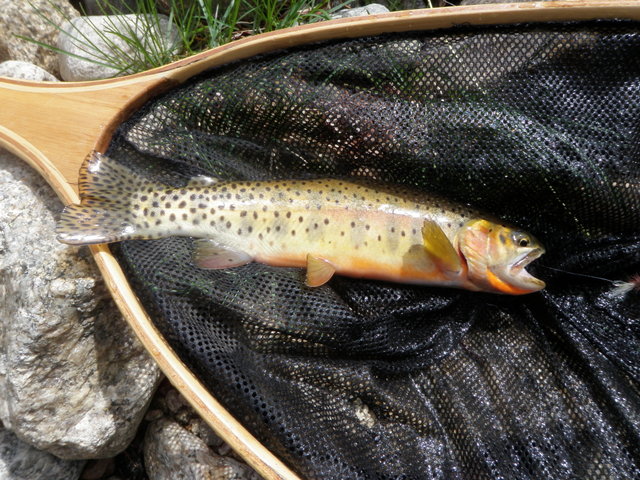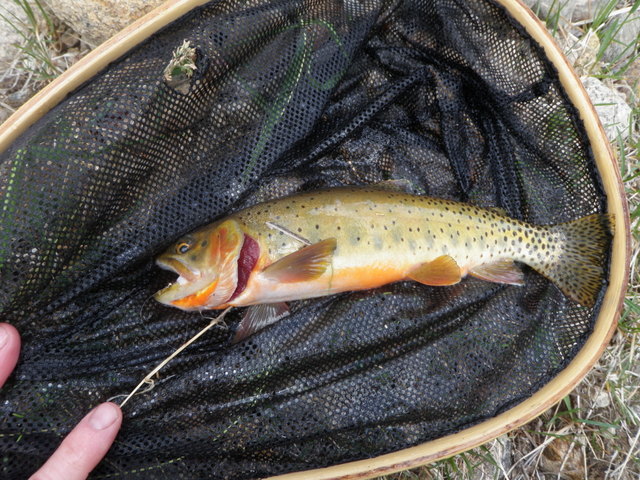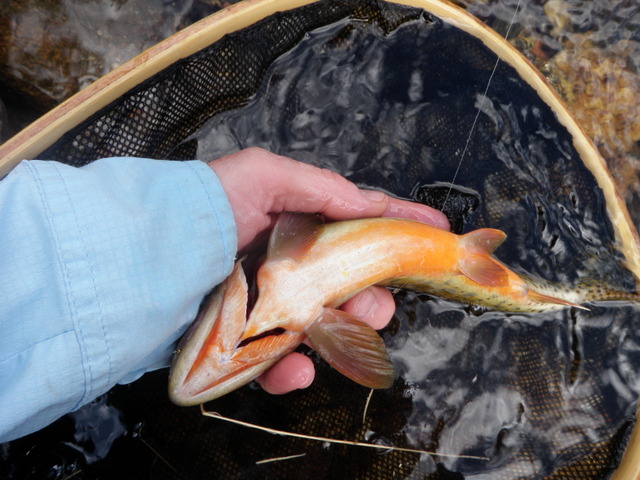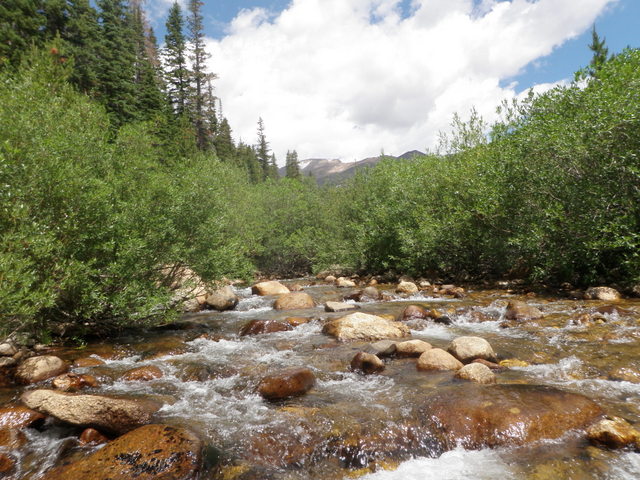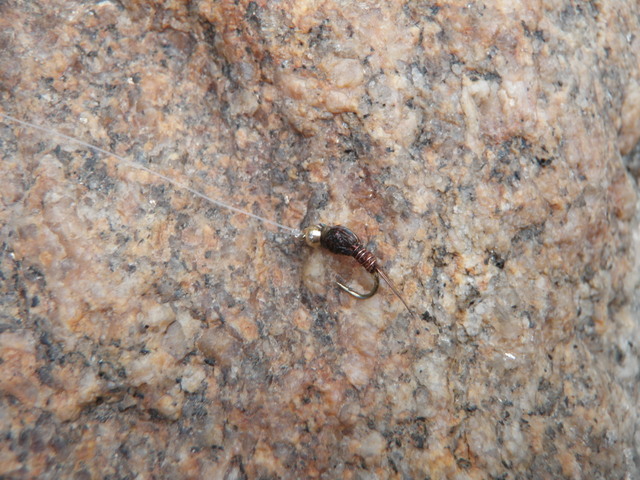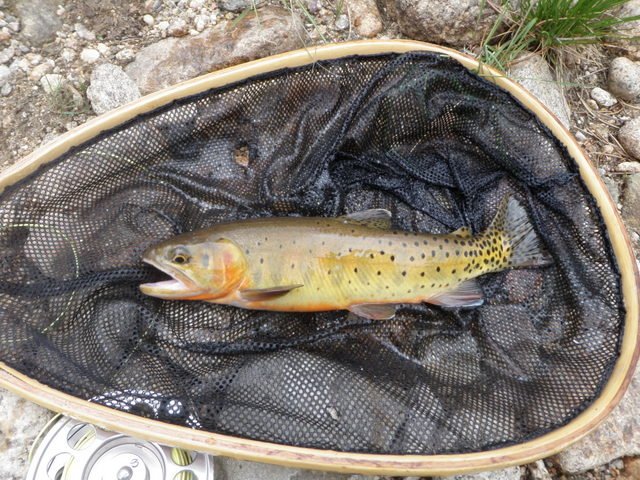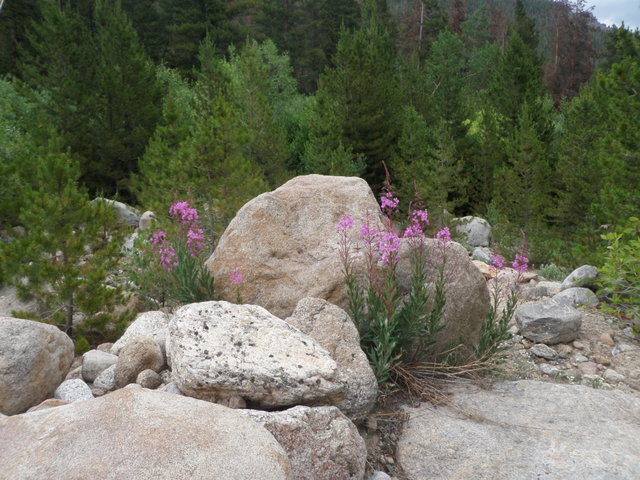Time: 10:30AM – 3:30PM
Location: Upstream from Ypsilon Lake Trail crossing.
Fish Landed: 28
Roaring River 06/28/2012 Photo Album
Wildfires are everywhere. The last time I can remember weather and fires like now was 2002, another year of low snowpack, drought, and the Heyman Fire along the South Platte. But 2012 features brutal high temperatures and more wind than I can ever recall, the perfect storm for wildfires.
I wanted to spend a day fishing and escape the heat and not be near a fire so I elected to drive north to Rocky Mountain National Park and then hike up the Lawn Lake Trail to fish in the Roaring River for greenback cutthroat trout. I knew that the fish wouldn’t be large, but this alpine setting with the most beautiful trout in the world appealed to me. I arrived at the trailhead parking lot by 9:30AM and carefully transferred all the necessary equipment for a day of high country fishing to my backpack including lunch, rain gear, and most importantly an adequate supply of the flies that I expected to produce.
I began the unrelenting ascent and arrived beside the Roaring River in forty minutes where I shed my heavy load and climbed into my waders. I was also anxious to test my new Orvis Access four weight rod on the small greenback cutthroats as it is quite light and ideal for small stream fishing. Already at 10:30 it was quite warm, although there were quite a few white puffy clouds to occasionally block the rays of the bright sun. I elected to hike a bit downstream from my base camp position and started fishing back upstream. I figured I’d fish back up and beyond my base area by noon when I’d break for lunch. I initially tied on a lime green trude hoping it would imitate early season stoneflies.
It didn’t take long before I landed a small greenback and then a second larger specimen that I photographed. Both fish smashed the lime green trude, but as I covered more pockets I began to notice refusals. This type of fishing reinforces the value of good polarized sunglasses as I can see fish move toward my fly beneath the surface, and this information is valuable in determining the effectiveness of my imitations. I decided that based on previous experience I should be catching more fish, so I added an epoxy black sinking ant that Jeff Shafer had given me as a dropper off the trude. Using my sunglasses to see beneath the surface, I noticed two fish tap the ant, but in both cases I set the hook and only succeeded in whipping my flies back toward me. The takes seemed to be tentative so I once again reeled up my flies and switched the hard ant for a beadhead pheasant tail.
The lime green trude and BHPT combination proved to be a winner and before breaking for lunch I landed eight more fish besides the two I described at the outset. Two rose to the trude and six hammered the BHPT. The fish that took the BHPT seemed to grab it at the lip of a pocket or run as I lifted to make another cast.
I enjoyed a nice lunch overlooking the stream and resumed fishing at 12:30 at the point where I’d quit for lunch. After lunch I covered a lot of stream making two or three casts to likely spots. If I received a refusal, I didn’t dwell on that fish and just moved on assuming there were takers elsewhere. The green trude was now being refused with increasing frequency so I experimented with a different top fly. I liked the idea of using a buoyant Chernobyl ant as a strike indicator while I essentially nymphed with the BHPT. Unfortunately two fish were drawn to the Chernoyl but changed course at the last moment, so I had another refusal generator. What would ride high and be visible and suspend a nymph, but not create refusals? I spotted a bushy size 12 caddis with a palmered body in my patch so I pulled it out and tied it to my line as the top fly. It may have also been a light olive body small stimulator.
At any rate this proved to be a winner and I fished the olive caddis and beadhead pheasant tail for the remainder of the afternoon. Initially nearly all the fish were taking the pheasant tail but by 2PM some dark clouds rolled in and I heard thunder in the distance. These low light conditions for some reason caused the fish to become more interested in the caddis. I estimate that of the 18 fish landed after lunch, ten inhaled the nymph and eight smacked the caddis. It was great fun moving quickly, flicking short casts with my new rod to small pockets, and hooking beautiful feisty colorful greenbacks. Where else can you do this?
I was scheduled to meet Jane at 6PM at the 243 exit of interstate 25, so I stopped fishing at 3:30. In addition the dark clouds were closer and the rumbling louder, so I was concerned about getting caught in a high country thunderstorm. I wore my rain jacket around my waist and below my backpack on the return hike just in case. I experienced only light rain on the trip down the mountain; not enough to put on my raincoat. I actually needed to stop and kill a bit of time in Lyons at a park in order to not be at the park and ride too early.
Jane arrived at the scheduled time and we continued on to Ft. Collins where we traded in her 2000 Honda Accord for a pre-owned Kia Forte. It turned out to be a fairly late evening, but I was happy with the memories of greenback cutthroats throbbing on my new fly rod.

